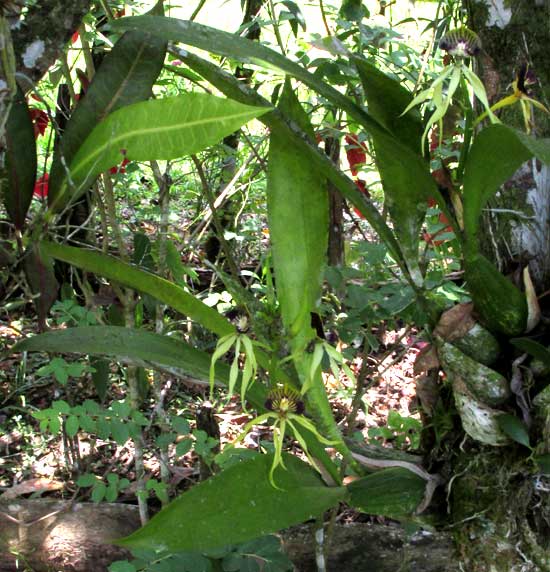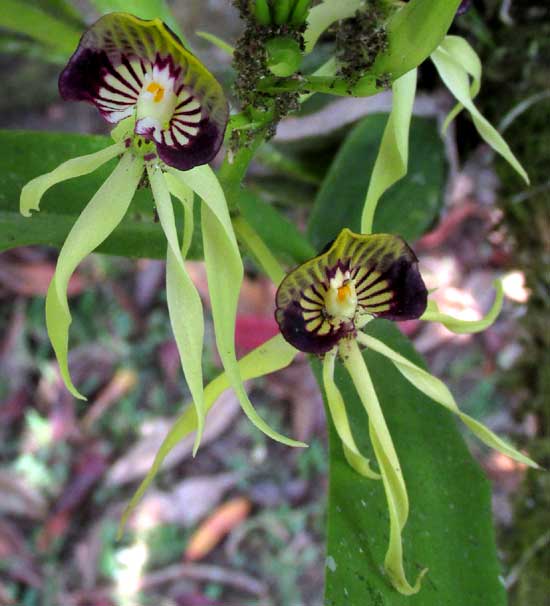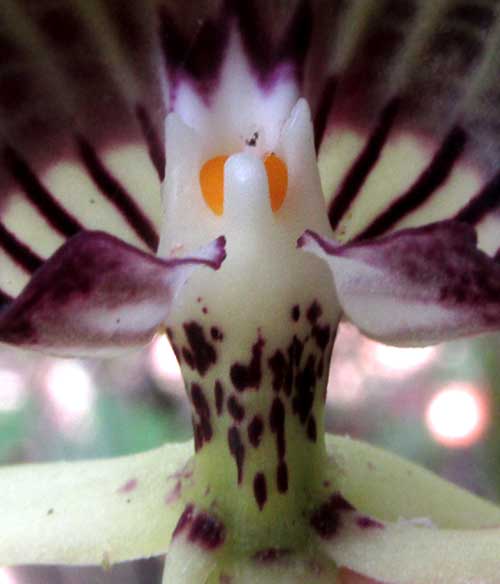Excerpts from Jim Conrad's
Naturalist Newsletter
from the May 22, 2016 Newsletter with notes from a visit in mid April to Lacanja Chansayab in the Lacandon Reserve; elevation 200m (650ft), N16.604°, W90.917°; Chiapas, MÉXICO
COCKLESHELL ORCHID
In mid April when I was in the Lacandon community of Lacanja Chansayab in Chiapas's Lacandon Reserve in extreme southeastern Mexico, beside the informal little family campground where I pitched my tent, a Lacandon lady maintained a shady little spot where she hung orchids among tree limbs and planted colorful ornamentals. The orchids were species found in the surrounding woods. She must have sprayed the area regularly with a water hose because most of the orchids were flowering, despite its being the heart of the dry season. Below, you can see one of the orchids growing on the trunk of a tree

An important field mark shown in this picture is that the orchid's ten-inch-long (25cm) leaves arise from atop green, pear-shaped, somewhat flattened "pseudobulbs," which are modified stem segments. In areas with long dry seasons, orchids with pseudobulbs may lose their leaves during the dry months, its pseudobulbs storing water, and then when the rainy season comes -- or even a little before -- new leaves sprout atop the pseudobulbs. Some groups of orchids have pseudobulbs and others don't.
Up close, the flowers -- which are about three inches across (8cm) -- show themselves as not only very pretty but also unusual, as seen below:

The long, slender, pale green petals and sepals are one thing to note, but in terms of normal orchid anatomy these blossoms do something special. A typical orchid blossom bears three sepals and three petals. Of the three petals, two are alike but the third usually is enlarged, forming a "lip" extending forward. The lip can be large and showy as in the ladyslippers, and some lips bear backward pointing "spurs." But the vast majority of lips arise as the flower's "chin" -- the lower part of the blossom's "face." Our Chiapas orchid has twisted its lip around so that it arises at crown, forming a colorful backdrop to the sexual parts -- the gynandrium or column -- like a decorative bonnet around a lady's face. A close-up of the gynandrium is shown below:

The gyandrium, or column, is the main distinctive feature of the Orchid Family. It consists of the flower's grown-together stigma, style and stamens. The Orchid Family is considered one of the most highly evolved, newly arisen plant families, and the gynandrium displays Nature's inexorable evolutionary trend to reduce, simplify and merge as evolution takes place.
With such distinctive features, this orchid was easy to identify as PROSTHECHEA COCHLEATA, in English sometimes known as the Cockleshell Orchid. It's native throughout Central America, the Caribbean -- including southern Florida -- and northern South America. Usually it's not listed as a Mexican species, though it's been reported as used by the Lacandon people in Chiapas's Lacandon Reserve. Its use was as a soap. I've heard of people elsewhere working up a lather by beating split-open orchid pseudobulbs in water, so maybe that's what they're talking about here. In Central America it's reported that the sticky juice that can be squeezed from the pseudobulbs has been used as an adhesive.
The Cockleshell Orchid is the National Flower of Belize. Commercial orchid growers have produced several hybrids using this species.